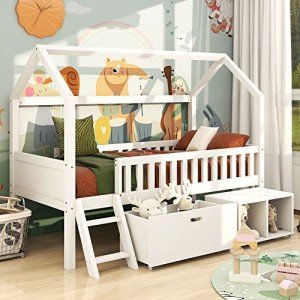The Ultimate Guide to Bunk Beds in the UK: Trends, Safety, and Benefits
Bunk beds have reigned supreme on the planet of kids's furnishings for numerous years. Their dual functionality, capability to save space, and distinct beauty have actually made them a desirable choice for families across the UK. As families grow and space ends up being a premium, bunk beds develop to meet numerous needs, visual appeals, and security concerns. This article checks out the patterns, benefits, safety concerns, and considerations of purchasing bunk beds in the UK.
Table of Contents
- Introduction
- Popular Bunk Bed Designs
- Benefits of Bunk Beds
- Safety Considerations
- Maintenance of Bunk Beds
- FAQs
- Conclusion
1. Intro
Initially designed for making the most of space in little bedrooms, bunk beds have grown to incorporate a variety of designs and performances. From Bunk Beds House to modern-day loft beds with integrated storage, the marketplace in the UK provides a myriad of choices for parents and children alike. This versatility appeals not only to those with space restraints but also to households trying to find trendy furnishings that can accompany children as they grow.
2. Popular Bunk Bed Designs
Bunk beds can be found in a wide array of styles dealing with various tastes and requirements. Here are some popular designs found in the UK market:
| Design Type | Description |
|---|---|
| Standard Wooden | Timeless design; available in numerous finishes; sturdy and ageless. |
| Metal Bunk Beds | Lightweight, often with a contemporary or commercial appearance; simple to move. |
| Loft Beds | Raised beds that supply underneath space for desks, storage, or play. |
| Futon Bunk Beds | A mix of a futon and bunk bed; suitable for multi-purpose spaces. |
| L-Shaped Bunk Beds | Two beds positioned in an L-shape; great for taking full advantage of corner areas. |
3. Advantages of Bunk Beds
Investing in a bunk bed provides a number of benefits:
- Space-saving: Bunk beds are best for small bedrooms, permitting 2 kids to share a space without sacrificing space.
- Adaptability: Many bunk beds come with features such as pull-out rotates, desks, or storage drawers, making them multifunctional.
- Motivates Sharing: Bunk beds can foster a sense of friendship and sharing amongst siblings or good friends.
- Trendy Aesthetics: With different designs readily available, bunk beds can serve as a trendy addition to a bed room rather than simply a functional piece of furniture.
- Cost-effective: Instead of purchasing 2 beds, a bunk bed enables more affordable use of space while accommodating more kids.
4. Security Considerations
When it pertains to bunk beds, safety is critical, specifically for younger kids. Here are some vital security pointers:
- Choose tough building: Look for bunk beds made from solid wood or durable metal to ensure resilience.
- Make sure correct height: The top bunk needs to adhere to safety standards, normally having at least 16 inches of guardrail on the side.
- Inspect weight limits: Ensure the bunk bed supports the weight of the designated users conveniently.
- Utilize the right mattresses: Use bed mattress sizes that fit snugly within the bed frame to avoid gaps where a child might become trapped.
- Establish guidelines: Make sure children understand the guidelines of bed use, such as no leaping and only one person on the leading bunk.
5. Upkeep of Bunk Beds
Bunk beds require routine upkeep to ensure they remain safe and functional. Here are some upkeep ideas:
- Regularly check hardware: Check screws and bolts to guarantee they stay securely fastened and safe and secure.
- Tidy mattresses: Regularly vacuum and spot tidy mattresses to preserve hygiene.
- Prevent overcrowding: Make sure the bed is not overwhelmed with toys, clothing, or other items.
6. FAQs
Q1: What age is ideal for kids to sleep in bunk beds?A1: Most
professionals suggest that children under the age of 6 must not sleep on the leading bunk due to safety concerns relating to falls.
Q2: Can bunk beds fit in any space size?A2: While bunk beds
are developed to save space, they still need adequate ceiling height for safety. Generally, a space should have at least 7.5 to 8 feet of ceiling height. Q3: Are bunk beds safe for toddlers?A3: While some bunk beds are developed specifically for young children,
the majority of professionals suggest that kids under the age of six need to use the bottom bunk for security. Q4: How do I clean up a bunk bed?A4: Regular cleansing can be done using a moist cloth for the wooden or
metal surfaces. Mattresses ought to
be vacuumed and cleaned according to manufacturer guidelines. 7. Conclusion Bunk beds have actually ended up being an iconic furniture piece for kids's spaces in the UK, using an ideal mix of performance, design, and space-saving capabilities. With various designs and advantages, bunk beds cater to households of all sizes and requirements. However, security must always be leading of mind when considering these kinds of beds. By making informed choices and preserving your bunk bed appropriately, you can guarantee that it stays a treasured furniture piece for many years to come. As bunk beds continue to develop, they provide more than simply a sleeping arrangement-- they develop memories and foster relationships, proving to be an important addition to British
homes. This extensive guide intends to arm prospective purchasers with valuable insights into the world of bunk beds in the UK, guaranteeing that they make informed options that prioritize both functionality and security.

